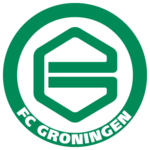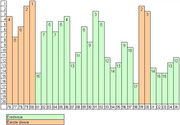FC Groningen
 |
|||
| Full name | Football Club Groningen | ||
|---|---|---|---|
| Nickname(s) | Pride of the North Green-White Army |
||
| Founded | June 16, 1971 | ||
| Ground | Euroborg Groningen (Capacity: 22,329) |
||
| Chairman | |||
| Manager | |||
| League | Eredivisie | ||
| 2009–10 | Eredivisie, 8th | ||
| Website | Club home page | ||
|
|||
FC Groningen is a football club from Groningen in the Netherlands.
Contents |
History
GVAV
The predecessor of FC Groningen was founded as Unitas in 1915. When Unitas joined the Eerste Klasse Noord their name was changed to GVAV (Groningen Football and Athletics Association). The Eerste Klasse Noord was a football league that consisted of teams from the northern provinces Groningen, Friesland and Drenthe, of which the winner went on to compete for the national title. During the days of the Eerste Klasse Noord GVAV stood in the shadow of Be Quick 1887 and Velocitas, two other sides from the city of Groningen. After the KNVB allowed professionalism in 1954 the Eerste Klasse Noord, along with the other regional leagues, ceased to exist. From the city of Groningen the teams GVAV, Be Quick 1887, Velocitas and Oosterparkers turned professional but the latter two soon had to step back to amateurism. Be Quick stayed professional until 1964, leaving GVAV as the only professional football team in the city of Groningen. In 1971 GVAV was reformed as FC Groningen.
FC Groningen
FC Groningen enjoyed top flight football for most of their existence, although the club was relegated to the second division after the third season of their existence.
The club was then propelled back into success by the Koeman brothers, Ronald Koeman and his elder brother Erwin Koeman together with defending midfielder Jan van Dijk resulting in qualification to European football for the first time in the 1982/83 season. Their best season in the Eredivisie was during the 1990/91 season when they finished third.
The club plays its home games in the 22,000 seat Euroborg stadium. In December 2005, the club played its last match ever in the 12,500 seat Oosterpark Stadion after having played there for 72 years. The average attendance in 2004/05 was 12,500 people. This has risen to just below 22,000 people in the new stadium. There are plans to expand the stadium to a capacity of 30.000 or 40.000. The Euroborg Stadium is known to be one of the more atmospheric of all Dutch stadiums. Despite its relative short existence, it has already earned the nickname the Green Hell.
2005-06 season

The 2005-06 season turned out to be one of the best in a long time for FC Groningen, with the club finishing 5th place in the league. This allowed Groningen to enter the play-off tournament for the UEFA Champions League third round qualification. However, they were beaten by Ajax in the finals who scored a goal two minutes before the final whistle.
By finishing fifth in the league, FC Groningen qualified for European football for the first time in 14 years, where they were defeated 4–3 on aggregate in the first round by Partizan Belgrade.
2006–07 season
In the 2006/07 season FC Groningen again managed to get an entrance for the UEFA Cup. They ended the season on an 8th place but thanks to the play-off tournament system, in which they beat Feyenoord and FC Utrecht, they qualified for the UEFA Cup where they faced ACF Fiorentina in the first round. Both matches in Groningen and Florence ended in a draw, 1–1. FC Groningen were defeated after penalties and knocked out in the first round.
In the season of 2008–2009 they almost set the Euroborg on fire with burning toilet paper. At the end of the 2009–2010 season Ron Jans, who has been the manager of FC Groningen for 8 years, is going to stop managing FC Groningen.
Crest and colours
When GVAV was reformed as FC Groningen in 1971 a competition was subscriped to come up with a new crest. The winning design was created by Reint Rozema. It showed a rather abstract character G, referring to Groningen. The "simple but strong shape of the crest" (as it was described by Rozema) had to symbolize the nature of the people of Groningen. The crest's form was inspired by the truncated icosahedron pattern of a football. In 1993 the mythical flying horse Pegasus was added to the crest. The supporters resisted agianst this alternation and the crest was restored to its original form in 1996.
FC Groningen's official colours are the city's green and white. However the crest was green and white from the beginning, the team's first ever home kit was purple. After the club's first season, the purple kit was exchanged for a green and white one. FC Groningen have played in these colours ever since. The design of the shirt has differed until 1991, when a kit with two vertical stripes was adopted as FC Groningen's standard[1]. Since 2006 the colour purple has been revived as the team's third colour and is used in the away kits[2].
Current squad
For recent transfers, see List of Dutch football transfers summer 2009 and List of Dutch football transfers winter 2009-10.
Note: Flags indicate national team as has been defined under FIFA eligibility rules. Players may hold more than one non-FIFA nationality.
|
|
Out on loan
Note: Flags indicate national team as has been defined under FIFA eligibility rules. Players may hold more than one non-FIFA nationality.
|
Reserve squad
Note: Flags indicate national team as has been defined under FIFA eligibility rules. Players may hold more than one non-FIFA nationality.
|
|
Notable players
|
|
See also
- Dutch football league teams
References
- ↑ Harris. "Harris FC Groningen supporters site". Trotsvanhetnoorden.nl. http://www.trotsvanhetnoorden.nl/shirts.php?id=2&sid=81. Retrieved 2010-04-27.
- ↑ Harris. "Harris FC Groningen supporters site". Trotsvanhetnoorden.nl. http://www.trotsvanhetnoorden.nl/shirts.php?id=3&sid=82. Retrieved 2010-04-27.
External links
- Official website (Dutch)
|
|||||
|
|||||